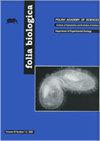Response to Global Warming of Eichwald's Toad, Bufo eichwaldi Litvinchuk, Borkin, Skorinov and Rosanov, 2008 (Anura; Amphibia) in Iran and Azerbaijan
IF 0.8
4区 生物学
Q4 BIOLOGY
引用次数: 1
Abstract
Global warming is considered to be a major threat to biodiversity and to have an erosive effect on the survival of endangered species. Amphibians are known as a vulnerable group of vertebrates that live and reproduce in both terrestrial and aquatic habitats. The subtropical regions of the world are among the land areas where amphibians will suffer the most from climate change. In the present study, the effect of climate change on Bufo eichwaldi inhabiting Hyrcanian forests was investigated. According to our results, the lowest temperature in the coldest season is the most important variable for the presence of this species. Due to the beginning of reproductive activity and mating taking place in late January until the end of February, this variable will have a direct effect on the rate of breeding and thus on the conservation of this species, because the species can find a new suitable area outside of high humanisation and increase its chance of successful breeding. Of course, climate change will cause the average annual temperature to rise by 2070, and this will favour the early onset of reproduction. Therefore, according to the analysis and scenarios considered in this study, global warming cannot have a negative effect on the toad species. However, a careful assessment of the status of other competing species in conjunction with the Talysh toad could provide a better explanation of the impact of climate change.艾奇瓦尔德蟾蜍对全球变暖的反应,Bufo eichwaldi Litvinchuk,Borkin,Skorinov和Rosanov,2008(Anura;两栖动物)在伊朗和阿塞拜疆
全球变暖被认为是对生物多样性的主要威胁,并对濒危物种的生存产生侵蚀性影响。两栖动物是一种脆弱的脊椎动物,在陆地和水生栖息地生活和繁殖。世界亚热带地区是两栖动物受气候变化影响最大的陆地地区之一。本研究调查了气候变化对栖息在卡尔卡尼亚森林中的艾奇瓦尔迪蟾蜍的影响。根据我们的研究结果,最冷季节的最低温度是该物种存在的最重要变量。由于繁殖活动的开始和交配发生在1月下旬至2月底,这一变量将对繁殖率产生直接影响,从而对该物种的保护产生影响,因为该物种可以在高度人性化之外找到一个新的合适区域,并增加其成功繁殖的机会。当然,到2070年,气候变化将导致年平均气温上升,这将有利于繁殖的早期开始。因此,根据本研究所考虑的分析和情景,全球变暖不会对蟾蜍物种产生负面影响。然而,与塔利什蟾蜍一起仔细评估其他竞争物种的状况,可以更好地解释气候变化的影响。
本文章由计算机程序翻译,如有差异,请以英文原文为准。
求助全文
约1分钟内获得全文
求助全文
来源期刊

Folia Biologica-Krakow
医学-生物学
CiteScore
1.10
自引率
14.30%
发文量
15
审稿时长
>12 weeks
期刊介绍:
Folia Biologica (Kraków) is an international online open access journal accepting original scientific articles on various aspects of zoology: phylogeny, genetics, chromosomal studies, ecology, biogeography, experimental zoology and ultrastructural studies. The language of publication is English, articles are assembled in four issues per year.
 求助内容:
求助内容: 应助结果提醒方式:
应助结果提醒方式:


